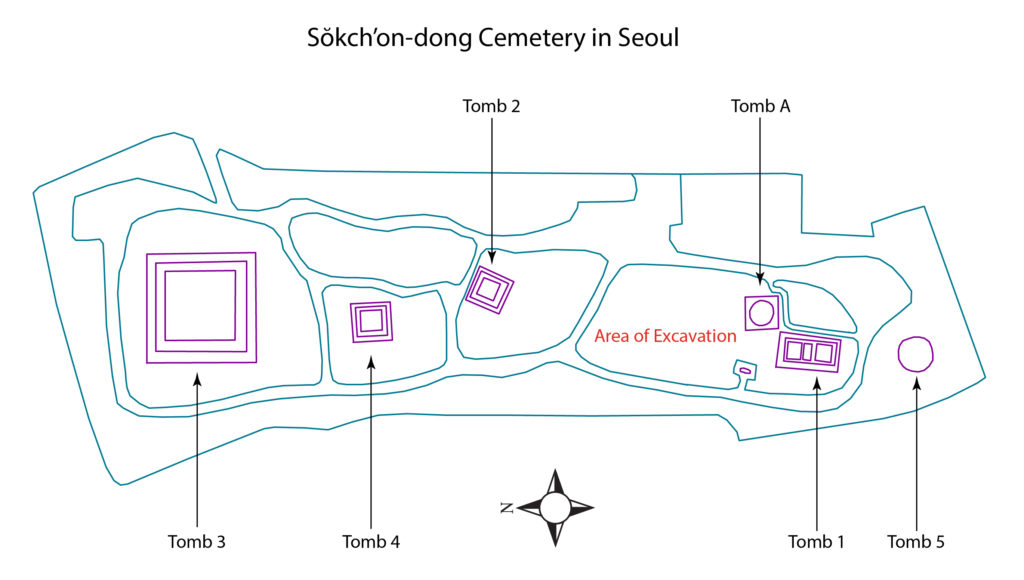2019
Early Paekche Stone-Mounded Tomb Complex Excavated at Sŏkch’on-dong in Seoul
Sŏkch’on-dong 石村洞 is the site of an elite cemetery of the early-period Paekche state, located in the Songp’a ward of Seoul south of the Han River (37.502323 127.102301). The cemetery was first surveyed in 1916–17, when it was found that at least 89 tomb mounds were still visible on the ground surface. The cemetery was not formally excavated until 1974, by which time urban development had destroyed the vast majority of the tombs, and the present-day cemetery represents only the westernmost edge of the original distribution. In 1974 only stone-mounded tombs 3 and 4 and earth-mounded tomb 5 were surveyed and restored. The Seoul National University Museum excavated Tombs 3 and 4 in 1983–84; then in 1986–87 tombs 1 and 2 were identified and restored, and the cemetery complex was organized as a public park. A variety of different tomb types were identified, including stone-mounded tombs, earth pit tombs with stone mounds, stone cist tombs, jar coffin tombs, and earth pit tombs. Stone Tomb A is the foundation of a stone-mounded tomb with a square exterior aspect and a circular interior structure, while nearby Tomb 1 was found to consist of a pair of conjoined stone-mounded tombs, characteristics relevant to the recent discoveries at this site.

In November 2015 test excavations conducted while investigating a sinkhole found in the area between tombs 1 and 2 uncovered remains of a stone foundation associated with the tombs. From October 2016 a series of excavations began at this location and uncovered a complex series of adjoining stone tomb foundations as well as associated ritual areas. During the 2016 excavations the foundations of some thirteen stone mound tombs were found an area about 40m by 40m. In the northern part of this area was a large stone-mounded tomb measuring about 13m per side, constructed of stones piled on a foundation of rammed earth. Other smaller tombs extend to the west, south, and east of the large tomb, all interconnected by various means. Some tombs were directly conjoined, while others were separated by a space that was subsequently filled with clay or stone. Although the upper portions of these tombs containing the burial chambers had been destroyed, a number of coffin nails and other iron fixtures were found throughout the site. Three wood-coffin tombs were found in the earthen mounds of some of the stone-mounded tombs, and two areas interpreted as ritual spaces were also found. One of these ritual spaces, a rectangular area bounded with stone embankments built to the east of and adjoined to the large tomb, yielded some 3,000 artifacts, including various fragments of pottery and lacquerware, horse jawbones, gold earrings, iron spearheads, and glass beads. The ritual area also yielded a large quantity of roof tiles, suggesting that a roofed structure once existed in the area.

During the fourth year of excavation (2019), the complex of interconnected stone tombs was found to be linked also to the already-known Tomb 1 (excavated in 1987) to the south as well as to Stone Tomb A located to the southeast. The entire complex is now understood as a single immense tomb mound with multiple interments, the interconnected complex extending at least 40m east and west and about 100m north and south. Further, a segment of a stone embankment was found to mark part of the northern boundary of the precinct for this tomb complex. This feature consists of two parallel stretches of a stone embankment separated by about 1.2m–1.5m arranged in conjoined segments demarcated by stone piles. Coffin nails and iron fixtures found in this feature suggest that it contained wood-coffin burials. Additional work was also conducted on the three ritual areas to the east of and associated with the stone-mounded tombs now numbered 1, 4, and 7. Human skeletal remains, weighing a total of 4.3kg, representing two or three individuals found at each ritual site, indicate that the bodies were cremated at a high temperature and the bones pulverized prior to deposition in the ritual space with other burial goods. Ritual Site No. 1 contained the largest number of artifacts, which show evidence of having been burned in place and then covered by earth. The practice of crematory burial for early Paekche elites marks a departure from previous funerary practice of the region, which featured wood-coffin burials in earthen pits.
Report by Mark E. Byington